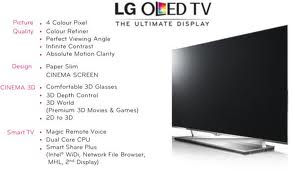In terms of TV screen sizes, the technology has indeed come
a long distance. There was a day when a size of 29 inch in the CRT TV was the
de rigueur – nay, the gold standard of TV ownership in India. Most people
actually managed with still smaller screens – 23 inches or thereabouts.
The charm of a large screen is easy to understand – if you
have ever been to a cinema theater. Larger screens make for a more absorbing,
immersive watching and entertainment experience.
 |
| Sony 4K Ultra HDTV |
Somewhere around the late 80s and early 90s, we had the DLP
rear projection TVs – which really set the pace in enlarging the screen sizes. Although
these became hugely popular with TV aficionados in the west, the idea never
really took root in India – mostly because of the costs involved.
Also, with the advent of LCD TVs, the screen sizes started
getting bigger. In fact, the advent and popularity of LCD TVs is not the only
reason of an increase in average screen size – the introduction of the HD
format also played its part. With high definition screens, it actually became possible
to increase the screen dimensions without jeopardizing the picture quality.
However, with liberalizing economy, Indian consumers have
been exposed to new technology, new products and also acquired willingness to
spend with increased buying power. The buying preferences of Indian TV users
are also getting aligned to the global trend of bigger screens – even if with
some time lag.
 |
| LG 84LM9600 Ultra HD TV |
As a result, the Indian consumers have recently been a part
of the global launches of some of the largest TV screen sizes in the business. First
we had the 42 and 47 inch screens, which slowly stretched to 55 inches (such as
that of LG LM8600) and 60 inches. Soon, 65 inch screens followed (LG LW6500),
closely followed by the biggest screen size available for a long, long time in
India – the 72 inch screen of LG LM9500.
The latest in large screen size TVs is certainly an eye
opener in every sense – 4K Ultra HD TVs. Recently, two consumer electronic
giants introduced huge 84 inch screens in quick succession – LG and Sony. While
LG was the first to introduce an 84 inch screen Ultra HD TV – named a LG
84LM9600, Sony followed soon with its own version of 4K TV – Bravia KD-84X9000.
Significantly, both the TVs are passive 3D TVs (probably Sony also has a LG
made LCD panel) and are priced almost equal – at Rs 17 lakhs.






